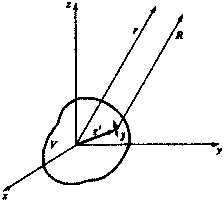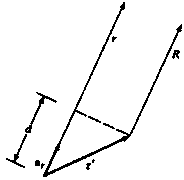FUNDAMENTALS OF
ELECTROMAGNETIC RADIATION
2.6 RADIATION FROM ARBITRARY CURRENT
DISTRIBUTIONS
In this section we will present
some useful formulas for calculating the far-zone radiation field from an
arbitrary distribution of current. Consider a volume V with a current
distribution
![]() , as shown in Fig. 2.9. The current element
, as shown in Fig. 2.9. The current element
![]() �will contribute an
amount
�will contribute an
amount
![]()
to the total vector potential
where
![]() . In the far‑zone region
. In the far‑zone region
![]() for all r' in V. Thus all rays from the various current
elements to the far-zone field point can be considered to be parallel to
each other, as shown in Fig. 2.9. Thus a useful approximation for R is
for all r' in V. Thus all rays from the various current
elements to the far-zone field point can be considered to be parallel to
each other, as shown in Fig. 2.9. Thus a useful approximation for R is
![]()
We
can replace
![]() �by
�by
![]() �in the amplitude term
for the vector potential, since this has a negligible effect on the amplitude
of each elementary contribution when
�in the amplitude term
for the vector potential, since this has a negligible effect on the amplitude
of each elementary contribution when
![]() . Hence in the far zone we obtain
. Hence in the far zone we obtain

This equation superimposes
the effects of each current element and takes into

![]()

�
Figure
2.9 An arbitrary distribution of current
account the relative phase
angle or path-length phase delay of each contribution. Since the current
elements do not, in general, contribute in phase, interference effects are
produced that may be exploited to control the shape of the radiation pattern.
In the next chapter we will examine the use of such interference effects to
produce high-gain directive radiation beams.
We can find the fields
![]() �and
�and
![]() �from Eq. (2.48) by
using the relations (2.13) and (2.18). When only the terms varying as 1/r are retained, it is found that
�from Eq. (2.48) by
using the relations (2.13) and (2.18). When only the terms varying as 1/r are retained, it is found that

![]()
The form of the integrand in
this expression shows that in a given direction, as specified by the unit
vector a, it is only the current perpendicular to
a, that contributes to the
radiation field. The reason for this is that the radiation held along the axis
of a current element is zero.
When the current is a line
current I along a contour C, then Ed. (2.49a ) can he expressed in the form

where a is a unit vector
along C in the direction of the current.
From
Eqs. (2.49a) and (2.50) we see that the electric field has the form
![]()
where
![]() , which is given by the integral, describes the radiation
amplitude pattern or the angular dependence of the radiation distribution in
space. The other factor
, which is given by the integral, describes the radiation
amplitude pattern or the angular dependence of the radiation distribution in
space. The other factor
![]() is the outward-propagating spherical wave function.
is the outward-propagating spherical wave function.